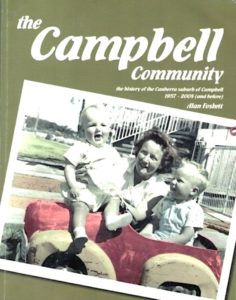The Campbell Community
– A book by Alan Foskett

See more videos on the History Page
As a result of generous financial support from the North Canberra Community Council, Alan Foskett’s 2008 book ‘The Campbell Community – history of the Canberra suburb of Campbell 1957 to 2008’ (after being out of print for many years) has been reprinted.
You can have your own copy for only $30.00 in GST. 100% of the proceeds will be used to write a new chapter on how Campbell has evolved in the last decade
TO ORDER YOUR COPY, complete your details below, We will follow up with payment transfer details and issue a tax invoice
The book, which helped to celebrate the suburb’s 50th Anniversary, was launched towards the end of 2008 by Sir Richard Kingsland at the Campbell Primary School. It was funded by the ACT Heritage Grants Scheme, and as well as being very popular, made significant contribution to Canberra’s heritage and history.
Campbell, named as a suburb on 25 May 1956, has a key place in our history and heritage of Canberra, especially in its role as a new community at the time when the city was about to shrug off its image as a bush capital and more positively towards becoming a worthy national capital and a city of world renown.
Campbell was named after the prominent merchant and landholder Robert Campbell of Duntroon Estate fame. The suburb was destined to have military presence and a direct relationship with the nation’s wartime history. It was linked on the eastern side by the Royal Military College (opened in 1911 at Duntroon) and later the Australian Defence Academy (1986), and on the western and northern sides of Walter Burley Griffins land axis (later Anzac Parade 1965) and the Australian War Memorial (original buildings 1941).
The defence connection was further emphasized in 1959 when the National Capital Development Commission decided to proceed with the construction of the Russell Offices Precinct. By March 1958 the planning and early construction plans for Campbell were in place and the suburb had welcomed its first permanent residents. They began to live close to where the only prior European settlement, the Russell Hill community and Anderson’s Cottage, had been located.
At the end of 1960 the suburb was extended to take in land which at that time included the Ainslie Migrant Hostel, the Australian War Memorial and also areas which later would be the sites for the Campbell High School, the CSIRO National Headquarters and 120 houses north of Fairbairn Avenue.
In the early 1960’s Campbell was a young supportive and baby booming community wanting to make the suburb into one of excellence, through local cooperation and mutual support. Such an environment continued as Campbell moved through the various stages of urban and demographic change to the point where it is a mature, diverse community.
In his forward to the book, author Alan Foskett said:
As the 50th anniversary of Campbell’s initial ‘modern day’ settlement is reached, this book will, I sincerely hope, help to identify and present the heritage and historical significance of the suburb’s first fifty years. It will bring back memories to many who were part of the pioneering days when, between 1957 and 1970. Campbell’s landscape changed from open, sparsely timbered grassland to a vibrant and cohesive community.
Alan went onto say “As author I wish to acknowledge the valuable assistance received from so many people and sources, with the fascinating individual and family stories of community and business life in Campbell, key elements of the book. There is also a need to keep in mind the urban history of the Campbell area before 1957, especially the historic significance of the Russell Hill Workers Settlement.
